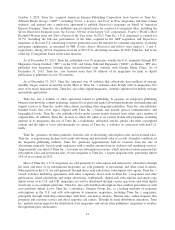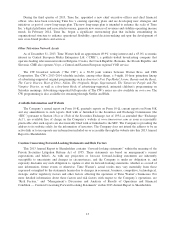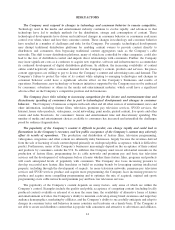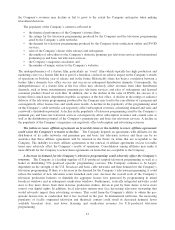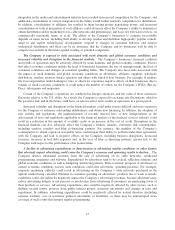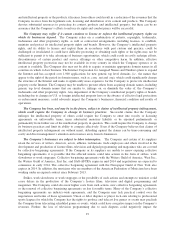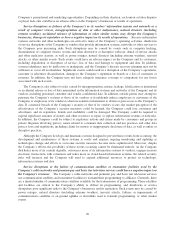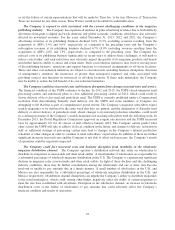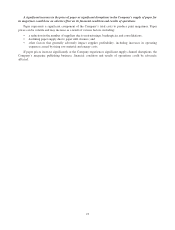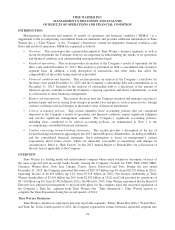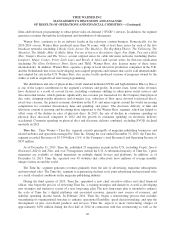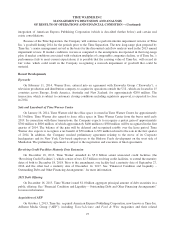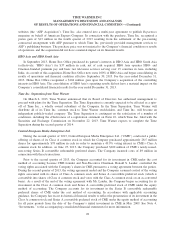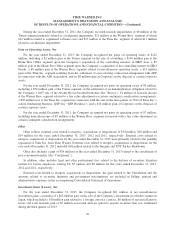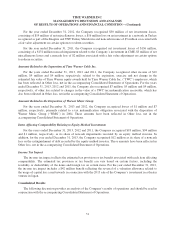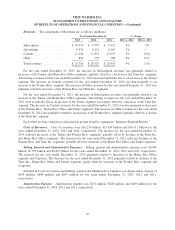Time Magazine 2013 Annual Report Download - page 38
Download and view the complete annual report
Please find page 38 of the 2013 Time Magazine annual report below. You can navigate through the pages in the report by either clicking on the pages listed below, or by using the keyword search tool below to find specific information within the annual report.or (ii) the failure of certain representations that will be made by Time Inc. to be true. However, if Transaction
Taxes are incurred for any other reason, Time Warner would not be entitled to indemnification.
The Company is exposed to risks associated with the current challenging conditions in the magazine
publishing industry. The Company has experienced declines in print advertising revenues due to both shifts by
advertisers from print to digital and weak domestic and global economic conditions, which have also adversely
affected its newsstand revenues. For the years ended December 31, 2013, 2012 and 2011, the Company’s
advertising revenues at its publishing business declined 0.6% (3.3% excluding revenues resulting from the
acquisition of AEP), 5.4% and 0.6%, respectively, as compared to the preceding years and the Company’s
subscription revenues at its publishing business declined 6.7% (8.0% excluding revenues resulting from the
acquisition of AEP), 4.8% and 1.5%, respectively, as compared to the preceding years. The Company has
reduced costs at its publishing business significantly in recent years to address these challenges, it will need to
reduce costs further, and such reductions may adversely impact the quality of its magazine products and brands
and further limit its ability to attract and retain talent. Such cost-reduction initiatives may involve moving more
of the publishing business’ operations and support functions to outsourced arrangements or off-shore locations.
These and other cost-reduction initiatives are subject to execution risk, including business disruptions, diversion
of management’s attention, the incurrence of greater than anticipated expenses and risks associated with
providing services and functions in outsourced or off-shore locations. If these risks materialize, the Company
may be unable to realize the full benefit of its cost-reduction initiatives.
The Company could face increased costs and business disruption from changes in postal rates and service.
The financial condition of the USPS continues to decline. In 2012 and 2013, the USPS closed numerous mail
processing centers and announced plans to close additional processing centers in 2014, which could result in
slower delivery of first class mail and periodicals mail. The USPS is currently prohibited under a Congressional
resolution from discontinuing Saturday mail delivery, but the USPS and some members of Congress are
attempting to lift that ban as part of comprehensive postal reform. The Company’s magazine subscribers expect
weekly magazines to be delivered in the same week that they are printed, and the elimination of Saturday mail
delivery or slower delivery of periodicals mail, absent changes to its internal production schedules, could result
in a certain percentage of the Company’s weekly magazines not reaching subscribers until the following week. In
December 2013, the Postal Regulation Commission approved an exigent rate increase and the USPS increased
rates by approximately 6% for all classes of mail effective January 2014. The Company cannot predict what
other actions the USPS will take to address its fiscal condition in the future, and changes to delivery, reduction in
staff or additional closings of processing centers may lead to changes in the Company’s internal production
schedules or other changes in order to continue to meet subscribers’ expectations. In addition, if there are further
significant increases in postal rates and the Company is not able to offset such increases, the Company’s results
of operations could be negatively impacted.
The Company could face increased costs and business disruption from instability in the wholesaler
magazine distribution channel. The Company operates a distribution network that relies on wholesalers to
distribute its magazines to newsstands and other retail outlets. A small number of wholesalers are responsible for
a substantial percentage of wholesale magazine distribution in the U.S. The Company is experiencing significant
declines in magazine sales at newsstands and other retail outlets. In light of these declines and the challenging
industry conditions, there may be further consolidation among the wholesalers and one or more may become
insolvent or unable to pay amounts due in a timely manner. A small number of wholesalers in the U.K. and
Mexico are also responsible for a substantial percentage of wholesale magazine distribution in the U.K. and
Mexico, respectively. Distribution channel disruptions can impede the Company’s ability to distribute magazines
to the retail marketplace, which could, among other things, negatively affect the ability of certain magazines to
meet the rate base established with advertisers. Disruption in the wholesaler channel, an increase in wholesale
distribution costs or the failure of wholesalers to pay amounts due could adversely affect the Company’s
financial condition and results of operations.
22


